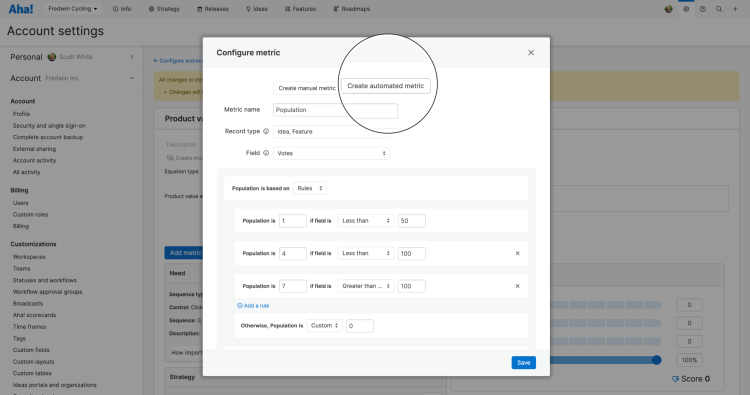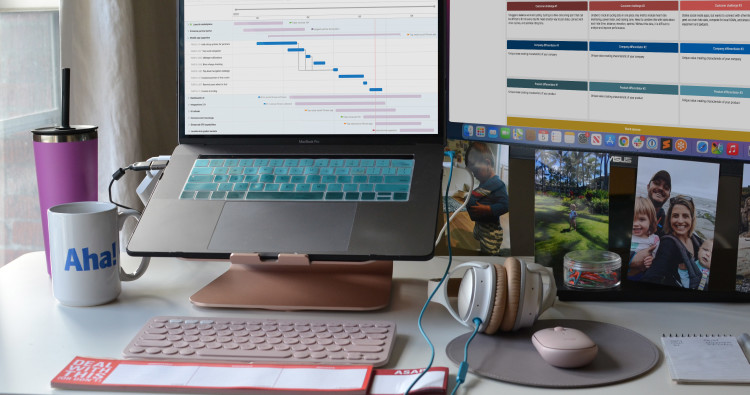
Automate scorecard metrics to keep product value scores aligned with your latest data.
Automatically Update Scorecard Metrics
"I love that we can now quantify the value of product development work." That was just one of the comments we received following our recent launch of the product value scorecard. The new scorecard helps you assess the potential value of new functionality at different stages of product development based on five core metrics — population, need, strategy, effort, and confidence. With today's update, you can take the scoring one step further to prioritize what matters most.
You can now automatically update scorecard metrics based on the value of other fields — bringing even greater consistency to your prioritization process.
Let's start with a quick overview of the default metrics that are included in the product value scorecard:
Population: How many customers will it impact?
Need: How important is it for those who require it?
Strategy: How closely connected is this to the company/product strategy?
Effort: How much work will it take to build?
Confidence: What is your level of confidence in each score above?
It is important to determine how you will rate each metric — so you can establish a consistent way to estimate value. This is where the product data you capture in Aha! can help. For instance, vote counts in your ideas portal are a good indicator of population impacted and overall need. And feature work estimates are a useful gauge of effort required. Referencing these data points as you update the metrics improves decision-making. Of course, you can already do this manually. But many of you asked for a way to automate it — so you can use the same approach to fill in metrics and keep them up to date.
The new functionality gives you the ability to use automation rules to calculate metrics based on values in standard and custom fields. For each rule, you will select the record type and field that you want to reference. You can use nearly any numeric or text field (including pre-defined and editable choice lists) and set how field values map to your rating scale. Once applied, your product value score will update automatically — and dynamically refresh as the underlying data changes over time.
The ability to auto-calculate scorecard metrics is available for customers in the Enterprise+ plan. This plan is ideal for complex organizations that demand the most sophisticated capabilities and a hands-on level of support from our concierge team. It also includes advanced security, backup features, and ongoing training services.
Let's take a look at two of the top-requested ways you told us you want to use this functionality:
Assess popularity based on idea votes
Prioritize what to build based on customer demand. Use the number of votes for each idea to determine the population metric on your scorecard. In the example below, we set up automation rules to map data ranges (less than 50 votes, 51 to 100 votes, and greater than 101 votes) to our 0–7 rating scale. As votes accumulate over time, the product value score will automatically increase — so you can adjust your plans accordingly.
Choose whether you want the metric value to be the same as the actual field value or use data ranges.
Calculate effort based on estimates
No more manually updating scores when estimates change. Below, we are using a custom field with a predefined choice list to estimate effort in t-shirt sizes. When we change the value from small to medium, the overall product value score decreases. This is because the scorecard formula subtracts effort from the overall score to account for the investment required to do the work. Of course, you could also use the standard estimate field in Aha! to auto-calculate effort based on story points or time.
You can update automated metrics by changing the value on the underlying record or manually overriding the metric directly on the scorecard.
Now you can make sure your scorecards always reflect the most current data — so you can make prioritization decisions with confidence.
This powerful functionality offers many possibilities for streamlining the way you assess the value of ideas and features. Need more inspiration? Check out our detailed support documentation to learn more. And do let us know how it goes — we love hearing how Aha! is helping your team deliver even more product value.
Upgrade to the Aha! Roadmaps Enterprise+ plan
Aha! Roadmaps is the best way to set strategy, capture ideas, score features, and share visual plans. Choose the Enterprise+ plan if you need the most sophisticated capabilities, advanced levels of support, security and backup features, as well as ongoing concierge services. Please contact us if you would like to learn more.




